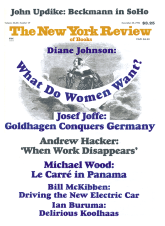The New York Times’s Tim Golden noted recently* that a full quarter of the New Yorkers of color sampled in a 1990 poll believed that their own government “deliberately makes sure that drugs are easily available in poor black neighborhoods in order to harm black people.” This impression of willful official malice was disturbing enough when registered by one out of every four African Americans. But now its contagions seem likely to swell further with a widening spread of reports that the Central Intelligence Agency stimulated the crack epidemic in the inner cities by flooding them with cocaine and using the profits to fund arms for the Nicaraguan contras.
And thus, once again, fantasy leaps to its customary function as distraction from reality. Theories of conspiracy are articles of belief only for the powerless, as the facts of public policy are articles of disbelief for the powerful, whose comforts and convenience depend upon denying them.
The fact of the CIA’s on-again, off-again consort with narcotics traffickers scarcely admits of dispute. Its purpose was, however, what it conceived to be freedom’s cause. Any incidental damage done the poor at home would have been beside the point. The CIA gives no more of a damn about the weal or woe of America’s poor than it does about Latin America’s.
Its views in this instance are in absolute harmony with those of the government that pays its way without worrying enough about where it is going. The government may fairly be acquitted of damaging the poor with witting stimulations of drug sales. That would be a conspiracy and, as usual, a fantasy. The actual damage government does the poor is taking away a child’s entitlement to a welfare allotment and guaranteeing Medicare as a seventieth birthday present for every millionaire. That is not a conspiracy but an attitude and, as always, a fact.
Golden has examined the case against the CIA as crack wholesaler and his verdict is in general dismissive. But then the best of journalists can scarcely go far enough to penetrate the immunity this agency has made ironclad simply by sealing off all information and then lying about any drop that seeps out. An instance is the little he has been able to find out about the two Nicaraguan narcotics distributors who found their market in South Central Los Angeles, who then tithed to the contra-arms campaign, and who now assert themselves as former CIA links.
The utmost that Golden can say about these claims is that he can find “no evidence” for them. And yet one of these narcomagnates, Juan Meneses, turns out to be blessed with and close to a brother so highly placed in the contra command as to be the peer of Enrique Bermúdez, its chief.
“Although Mr. Bermúdez, like other contra leaders, was often paid by the CIA,” Golden notes, “he was not a CIA agent.”
The maintenance of such distinctions without any essential difference is one of the more cunning of the infinite devices the agency employs on obfuscation. The CIA identifies highly placed foreign hirelings not as “agents” but as “assets.” General Manuel Noriega was an asset when he was expediting drugs and beating back Communists in Panama.
Colonel Julio Alpirez was also listed as an asset when he was running a Guatemalan intelligence unit subsidized by the CIA’s millions and had to be discharged with $44,000 as severance under clouds of suspicion that he had impermissibly extended to American citizens the homicidal zealotries he had until then decently reserved for Guatemalans. Emmanuel Constant was also an asset when he was directing the Revolutionary Front for the Advancement and Progress of Haiti’s (FRAPH) terror and, whether or not his severance papers included a year’s pay, he has been rewarded with an indefinite sanctuary in Brooklyn.
That is not a roster of assets overmuch to be disgraced by the company of a drug dealer or two. What we know is bad enough.
This Issue
November 28, 1996
-
*
October 17, 1996, p. A-19.
↩



